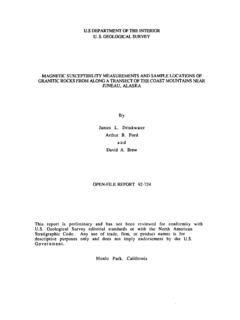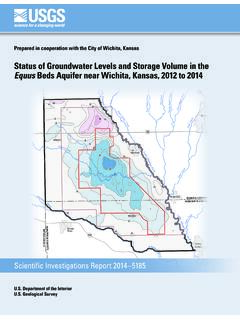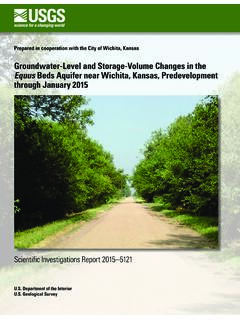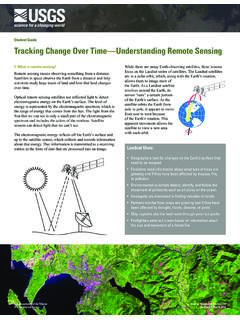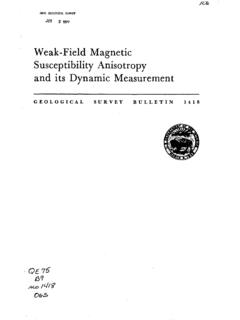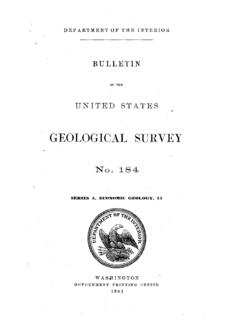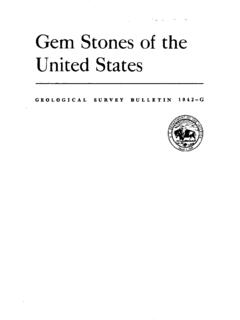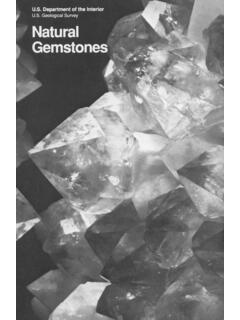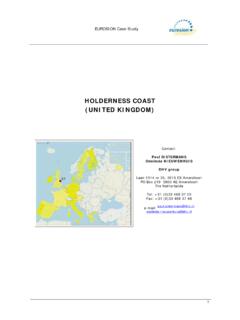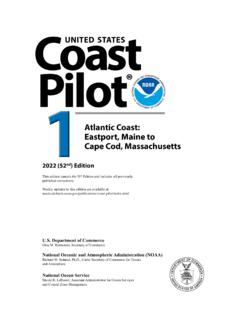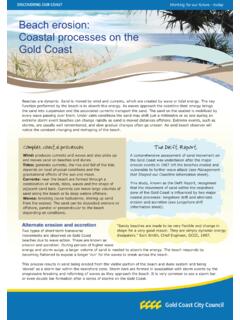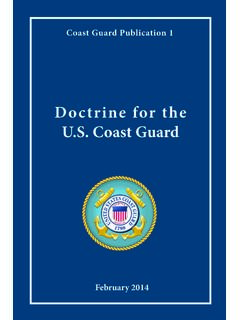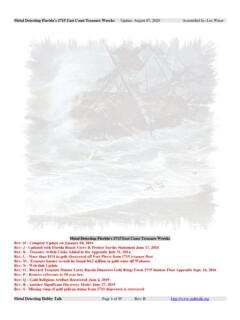Transcription of SALT-DOME LOCATIONS IN THE GULF COASTAL PLAIN ... - …
1 SALT-DOME LOCATIONS IN THE GULF COASTAL PLAIN , SOUTH-CENTRAL UNITED STATES. By Jeffery D. Beckman and Alex K. Williamson GEOLOGICAL SURVEY. WATER-RESOURCES INVESTIGATIONS REPORT 90-4060. A Contribution of the Regional Aquifer-Systems Analysis Program AUSTIN, TEXAS. 1990. DEPARTMENT OF THE INTERIOR. MANUEL LUJAN, JR., Secretary UNITED STATES GEOLOGICAL SURVEY. Dallas L. Peck, Director For more information Copies of this report can be write to: purchased from: Project Chief Geological Survey Geological Survey Books and Open-File Reports Section Gulf Coast RASA Box 25425, Federal Center N. Shore Plaza Bldg., Rm. 104 Denver, CO 80225-5425. 55 N. Interregional Hwy. Austin, Texas 78702. CONTENTS. Page 1. 1. Purpose and 3. Discrepancies between references .. 4. SALT-DOME LOCATIONS and method of 4.
2 dome names .. 6. dome name coding 18. Data 18. 19. References 20. ILLUSTRATIONS. Plate 1. SALT-DOME LOCATIONS in the Gulf of Mexico COASTAL PLAIN , south-central United States and the adjacent Continental Shelf In pocket Page . Figure 1. Gulf Coast Regional Aquifer-System Analysis study area boundary and location of salt basins .. 2. 2-11. Maps showing location of salt domes that penetrate the base of layers: 2. Layer 11 (permeable zone A).. 7. 3. Layer 10 (permeable zone B).. 8. 4. Layer 9 (permeable zone C).. 9. 5. Layer 8 (permeable zone D).. 10. 6. Layer 7 (permeable zone E).. 11. 7. Layer 6 (upper Claiborne aquifer).. 12. 8. Layer 5 (middle Claiborne aquifer).. 13. 9. Layer 4 (lower Claiborne-upper Wilcox aquifer).. 14. 10. Layer 3 (middle Wilcox aquifer).. 15. 11. Layer 2 (lower Wilcox aquifer).
3 16. 12. Graph showing number of salt domes that penetrate the base of the indicated 17. 13. Graph showing total number of salt domes and number of domes where depth to top is unknown, or is above or below top of Midway confining unit by area of salt dome 17. iii TABLES. [Table 2 at back of report]. Page Table 1. Comparison of sources used for locating domes and number of matches between each pair of sources., Table 2. Map code, SALT-DOME name, location, depth to salt and caprock, diameter and volume of salt domes, and sources of 23. CONVERSION FACTORS AND ABBREVIATIONS. "Inch-pound" units of measure used in this report may be converted to metric (International System) units by using the following factors. Multiply inch-pound units fix To obtain metric unit foot (ft) meter (m). mile (mi) kilometer (km) t o cubic mile (mi ) cubic kilometer (km 3 ).
4 Square mile (mi 2 ) square kilometer (km 2 ). ALTITUDE DATUM. Sea level: In this report, "sea level" refers to the National Geodetic Vertical Datum of 1929 (NGVD of 1929)--a geodetic datum derived from a general adjustment of the first-order level nets of both the United States and Canada, formerly called Sea Level Datum of 1929. iv SALT-DOME LOCATIONS IN THE GULF COASTAL . PLAIN , SOUTH-CENTRAL UNITED STATES. By Jeffery D. Beckman and Alex K. Williamson ABSTRACT. Information on salt domes in the Gulf of Mexico COASTAL PLAIN , south-central United States and the adjacent Continental Shelf were compiled from major published sources, 1973-84. The location of 624 salt domes is shown on a map at a scale of 1:1,500,000. A color coding system was used to show that the occurrence, size, shape, and location of these domes varies among sources.
5 Two tables of additional data accompany the map and include other available information such as: identifying sources, depth to salt and caprock, diameter, volume, name, and uppermost zone of surrounding sediment that is penetrated, as well as the number of matches between sources. * The LOCATIONS of salt domes that penetrate specific permeable zones within the gulf coast regional aquifer systems are shown on maps. INTRODUCTION. The Gulf Coast Regional Aquifer-System Analysis (RASA) covers an area of 230,000. square miles onshore and 60,000 square miles of the adjacent Continental Shelf (fig. 1). (Grubb, 1987). The aquifer system consists of Cenozoic sediments that were divided into aquifers, permeable zones, and confining units (Grubb, 1987, p. 104). This division was accomplished by: 1) Identifying areally extensive units of low permeability; 2).
6 Identifying large hydraulic conductivity contrasts between adjacent permeable zones not separated by a regional confining unit; and 3) identifying variations in hydraulic head with depth (Weiss and Williamson, 1985; Weiss, 1990; and Hosman and Weiss, 1988). Manuscript approved for publication April 12, 1990. MISSOURI. 50 100 150 200 MILES ILLINOIS. I. 50 100 150 200 KILOMETERS. KENTUCKY. ^. / /<%North Louisiana ". East Texas . Boundary of study area N salt Basin MISSISSIPPI. *' \^ J>' / ' Mississippi ~ salt Basin / Gulf Coast salt Basin , FLORIDA. Figure 1. Gulf Coast Regional Aquifer-System Analysis study area boundary and location of salt basins. The regional aquifers, permeable zones, and confining units were assigned layer numbers and are, from youngest to oldest Layer number Aquifer or Confining Permeable zone unit Mississippi River Valley alluvial aquifer and permeable zone A (Holocene-upper Pleistocene deposits) 11.
7 Permeable zone B (lower Pleistocene-upper Pliocene deposits) 10. permeable zone C (lower Pliocene-upper Miocene deposits) 9. zone D confining unit 17. permeable zone D (middle Miocene deposits) 8. zone E confining unit 16. permeable zone E (lower Miocene-upper Oligocene deposits) 7. Vicksburg-Jackson confining unit 15. upper Claiborne aquifer 6. middle Claiborne confining unit 14. middle Claiborne aquifer 5. lower Claiborne confining unit 13. lower Claiborne-upper Wilcox aquifer 4. middle Wilcox aquifer 3. lower Wilcox aquifer 2. Midway confining unit 12. t The layer numbers shown above will be used throughout the rest of this report for convenience. The Midway confining unit is the base of the flow system throughout much of the study area (Grubb, 1984). salt domes in the study area are found in five distinct regions.
8 These regions, known as salt basins, probably reflect thick accumulations of sedimentary salt . Overburden pressures and density differences created by later sedimentary deposits then caused the salt to flow into salt structures. The salt basins (fig. 1) are: South Texas, East Texas, North Louisiana, Mississippi, and Gulf Coast. The Gulf Coast salt basin, the largest, underlies southeastern Texas, southern Louisiana, and the adjacent Continental Shelf. PURPOSE AND SCOPE. This study was initiated under the Gulf Coast Regional Aquifer-System Analysis to compile published data on salt domes to the edge of the Continental Shelf. The composite data were compiled to study the possibility of salt domes as a source of salt in brine waters in Cenozoic sediments of the Gulf of Mexico COASTAL PLAIN in the south-central United States and adjacent Continental Shelf (Williamson and others, 1990, p.)
9 107). The shallowest permeable zone penetrated by each dome has been identified in order to assess the possibility of salt dissolution and movement through the permeable zones. In this report, the compiled data are displayed on a map and in a table. SALT-DOME LOCATIONS and geometry were compiled from eight sources, each of which investigated all or part of the study area. SALT-DOME name, location, depth to salt and caprock, diameter, volume, and identifying sources used for this compilation are provided in a table. DISCREPANCIES BETWEEN REFERENCES. Identification of salt dome LOCATIONS from each of the references used to construct plate 1 are compared in table 1. The discrepancies in dome identification between references are due to several factors. First, the more recent references reflect advances made in seismic surveying and other remote sensing methods of geophysics.
10 Therefore, some structures that were identified by earlier references as salt domes have been reclassified as non- salt structures, whereas other salt domes have been identified for the first time. For this reason, recent references were favored in compiling these data. Second, despite the advancements, identification of salt domes from seismic surveys remains highly subjective (such that two people using the same data may reach different conclusions). Third, the different investigations are based on different databases of raw material and published information. For example, the Department of the Interior (1983) lists neither Martin (1980) nor Halbouty (1979) as references. Halbouty (1979) lists only those salt domes that have been confirmed by drilling, so that his base list of 343 domes should be considered fundamental.
